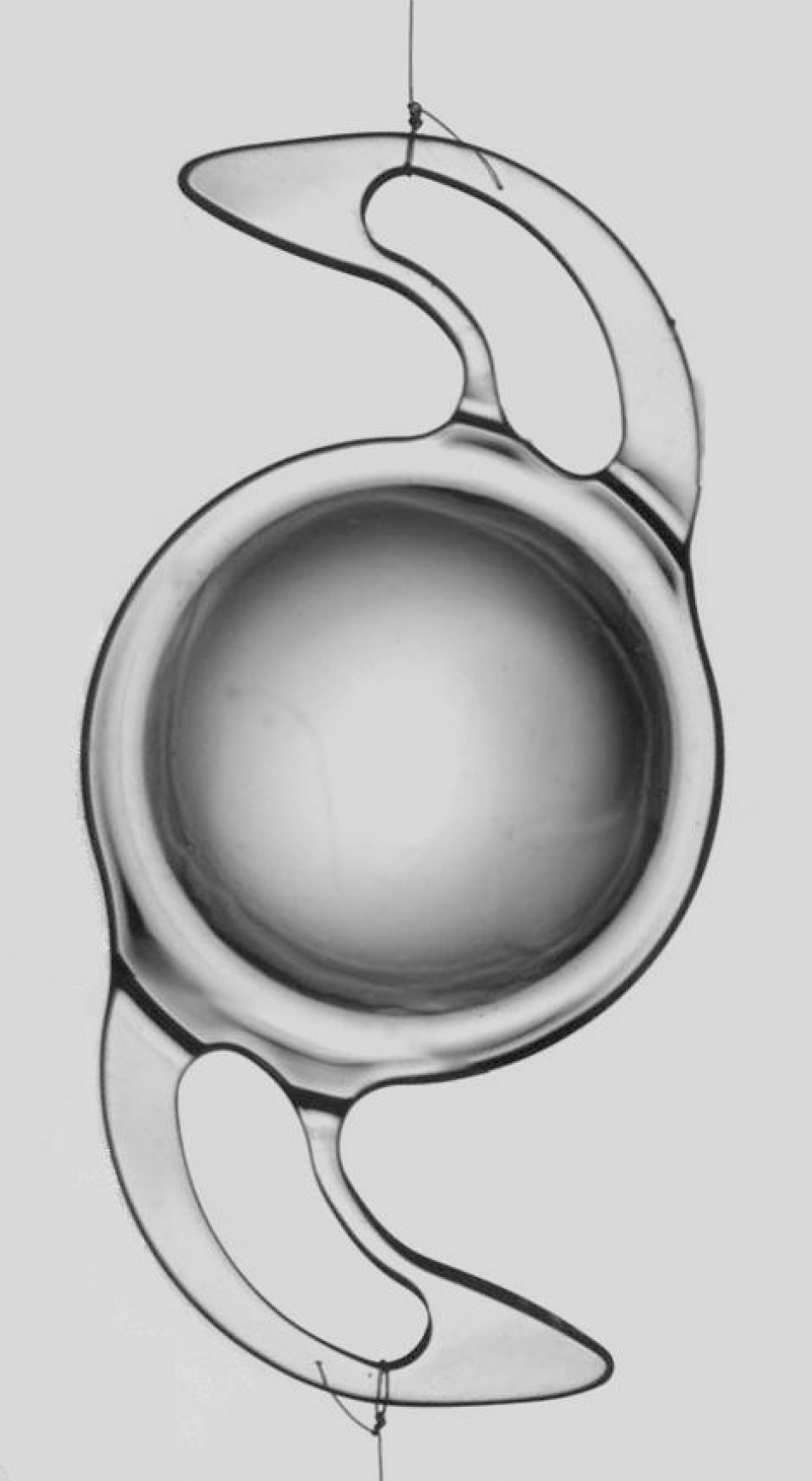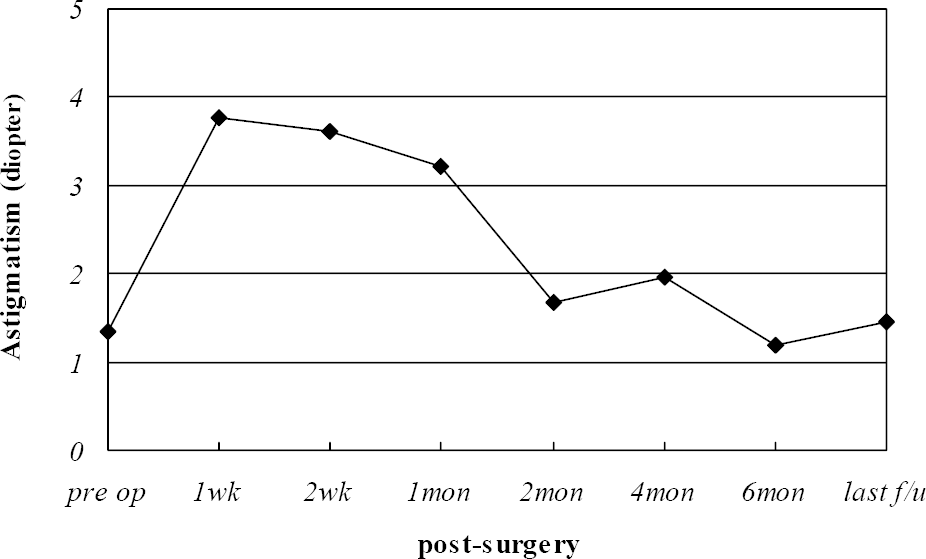Abstract
Purpose
To report the surgical results of transscleral fixation of foldable acrylic intraocular lens with a unique haptic shape (CORNEALⓇ, ACR6D, France).
Methods
We analyzed the medical records of 18 patients (19 eyes) who had transscleral fixation of posterior chamber intraocular lens implantation from July 2004 to July 2006.
Results
According to the cause of operation, there were five eyes with complicated cataract, eight with trauma, and six with aphakia associated with a previous operation. The mean age of the patients was 55.9±21.2 years. The mean preoperative best-corrected visual acuity was 0.31±0.35, and the postoperative value was 0.63±0.29 (p<0.05). The mean preoperative spherical refractive equivalent was 6.58±5.33 diopter, and the postoperative value was -1.77±1.59 diopter. The mean refractive error was -1.13±1.57 diopter. This showed a myopic shift (p<0.05). The mean astigmatism decreased with time, and it stabilized two months after the operation. The trend was toward mild against-the-rule astigmatism. The mean follow-up duration was 11.0±7.6 months.
Go to : 
References
1. Hu BV, Shin DH, Gibbs KA, Hong YJ. Implantation of posterior chamber lens in the absence of capsular and zonular support. Arch Ophthalmol. 1988; 106:416–20.

2. Stark WJ, Gottsch JD, Goodman DF, Gottsch J. Posterior chamber intraocular lens implantation in the absence of capsular support. Arch Ophthalmol. 1989; 107:1078–83.

3. Chan CK. An improved technique for management of dislocated posterior chamber implants. Ophthalmology. 1992; 99:51–7.

4. Kohnen S, Ferrer A, Brauweiler P. Visual function in pseudophakic eyes with poly (methyl methacrylate), silicone and acrylic intraocular lenses. J Cataract Refract Surg. 1996; 22:1303–7.
5. Oshima Y, Oida H, Emi K. Transscleral fixation of acrylic intraocular lenses in the absence of capsular support through 3.5 mm self-sealing incisions. J Cataract Refract Surg. 1998; 24:1223–9.

6. Abela-Formanek C, Amon M, Schauersberger J. . Results of hydrophilic acrylic, hydrophobic acrylic, and silicone intraocular lenses in uveitic eyes with cataract: comparison to a control group. J Cataract Refract Surg. 2002; 28:1141–52.
7. Davison JA. Positive and negative dysphotopsia in patients with acrylic intraocular lenses. J Cataract Refract Surg. 2000; 26:1346–55.

8. Saika S, Miyamoto T, Ohnishi Y. Histology of anterior capsule opacification with a poly HEMA/HOHEXMA hydrophilic hydrogel intraocular lens compared to poly (methyl methacrylate), silicone, and acrylic lenses. J Cataract Refract Surg. 2003; 29:1198–203.
9. Wagoner MD, Cox TA, Ariyasu RG. . Intraocular lens implantation in the absence of capsular support. Ophthalmology. 2003; 110:840–59.

10. Auffarth GU, Wesendahl TA, Brown SJ, Apple DJ. Are there acceptable anterior chamber intraocular lenses for clinical use in the 1990s? An analysis of 4104 explanted anterior chamber intraocular lenses. Ophthalmology. 1994; 101:1913–22.
11. Smith PW, Wong SK, Stark WJ. . Complications of semiflexible, closed-loop anterior chamber intraocular lenses. Arch Ophthalmol. 1987; 105:52–7.

12. Bellucci R, Pucci S, Morselli S, Bonomi L. Secondary implantation of angle-supported anterior chamber and scleral fixated posterior chamber intraocular lenses. J Cataract Refract Surg. 1996; 22:247–52.
13. Lee JG, Lee JH, Chung H. Factors contributing to retinal detachment after transscleral fixation of posterior chamber intraocular lenses. J Cataract Refract Surg. 1998; 24:697–702.

14. Durak A, Oner HF, Kocak N, Kaynak S. Tilt and decentration after primary and secondary transsclerally sutured posterior chamber intraocular lens implantation. J Cataract Refract Surg. 2001; 27:227–32.

15. Cahane M, Chen V, Avni I. Dislocation of a scleral-fixated, posterior chamber intraocular lens after fixation suture removal. J Cataract Refract Surg. 1994; 20:186–7.

16. Heilskov T, Joondeph BC, Olsen KR, Blankenship GW. Late endophthalmitis after transscleral fixation of a posterior chamber intraocular lens. Arch Ophthalmol. 1989; 107:1427.

17. Kay MD, Epstein RJ. Torczynski E. Histopathology of acute intraoperative suprachoroidal hemorrhage associated with transscleral intraocular lens fixation. J Cataract Refract Surg. 1993; 19:83–7.
18. Moon AR, Moon NJ, Choi KY. Long-term Results & Complications using Scleral-fixated Posterior Chamber Intraocular Lenses. J Korean Ophthalmol Soc. 1996; 37:1283–92.
19. Lee JM, Kim JH. A clinical study in transscleral fixation of foldable intraocular lenses. J Korean Ophthalmol Soc. 2004; 45:2014–20.
20. Duffey RJ, Holland EJ, Agapitos PJ, Lindstrom RL. Anatomic study of transsclerally sutured intraocular lens implantation. Am J Ophthalmol. 1989; 108:300–9.

21. Utrata PJ, Sander WB, Deluca M. . Small incision surgery with STAAR elastimide three piece posterior chamber intraocular lens. J Cataract Refract Surg. 1994; 20:426–31.
22. Ursell PG, Spalton DJ, Pande MV. . Relationship between intraocular lens biomaterials and posterior capsule opacification. J Cataract Refract Surg. 1998; 24:352–60.

23. Frohn A, Dick HB, Augustin AJ, Grus FH. Late opacification of the foldable hydrophilic acrylic lens SC60B-OUV. Ophthalmology. 2001; 108:1999–2004.

24. Kim JY, Tchah HW. The clinical results of hydrophilic acrylic lens. J Korean Ophthalmol Soc. 2001; 42:1562–70.
25. Ahn JW, Lee EH, Lee DH, Lew HM. Predictability of postoperative refractive error after secondary lens implantation. J Korean Ophthalmol Soc. 1999; 40:2785–92.
26. Lee SJ, Kim KC, Hong YJ. Implantation of posterior chamber intraocular lens by trans-scleral fixation. J Korean Ophthalmol Soc. 1992; 33:704–10.
27. Han JI, Shin SY, Song BJ. Scleral fixation of foldable posterior chamber intraocular lenses. J Korean Ophthalmol Soc. 2002; 43:1887–91.
28. Lee JE, Yoon TJ, Jea SY. . Sutured posterior chamber intraocular lens in the vitrectomized eye: Comparison of PMMA and AcrysofⓇ foldable lens. J Korean Ophthalmol Soc. 2004; 45:1268–75.
29. Chang JH, Lee JH. Effect of distances between corneoscleral limbus and transscleral sutures on vision and refraction in eyes with posterior chamber intraocular lens implanted by transscleral suture fixation. J Korean Ophthalmol Soc. 1993; 34:376–83.
Go to : 
 | Figure 1.Foldable acrylic intraocular lens (CORNEALⓇ, ACR6D, France). 10-0 ProleneⓇ sutures were fixed to the haptic of the lens. |
 | Figure 2.Astigmatism values [absolute value] versus time. The mean astigmatism decreased as time passed, and it stabilized 2 months after the operation. |
Table 1.
Patient demographics
Table 2.
Etiologies of operation
Table 3.
Surgical techniques
| Technique |
Eyes (N=19) |
|
|---|---|---|
| Number | (%) | |
| TS IOL only | 4 | (21.05) |
| TS IOL+pupilloplasty | 1 | (5.26) |
| SO removal+TS IOL | 4 | (21.05) |
| ECCE+AV+TS IOL | 2 | (26.31) |
| Phacoemulsification+AV+TS IOL | 1 | (5.26) |
| PPV+TS IOL | 7 | (36.84) |
Table 4.
Visual outcome
| Preoperative | Last follow up | |
|---|---|---|
| BCVA | 0.31±0.35 | 0.63±0.29* |
| 0.1 or worse, no. of ey | yes (%) 8 (42.11%) | 1 (5.26%) |
| 0.15 to 0.5, no. of eye | s (%) 7 (36.84%) | 8 (42.11%) |
| 0.5 or better, no. of ey | yes (%) 4 (21.05%) | 10 (52.63%) |
| S.E (diopter) | 6.58±5.33 | -1.77±1.59† |
| Refractive cylinder (diopte | er) | |
| Absolute value | 1.36±0.85 | 1.65±0.94 |
| Algebraic value | 0.07±1.66 | -0.68±2.26 |




 PDF
PDF ePub
ePub Citation
Citation Print
Print


 XML Download
XML Download